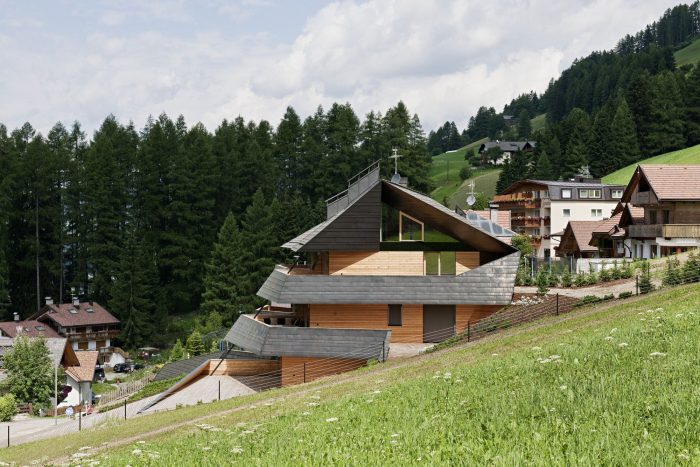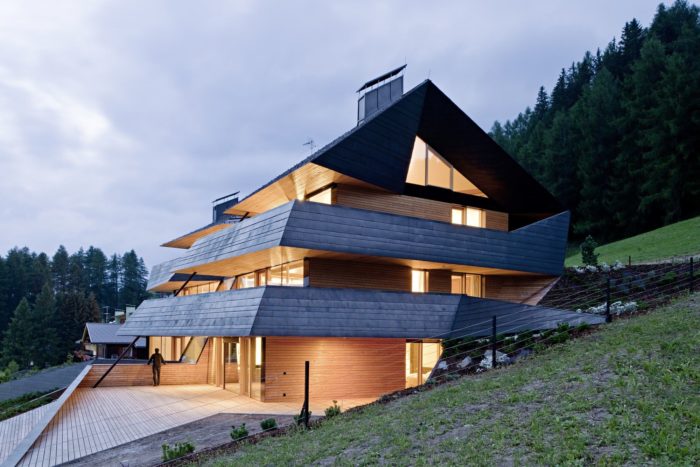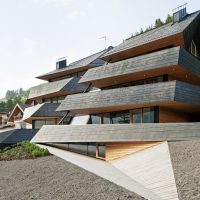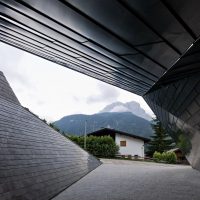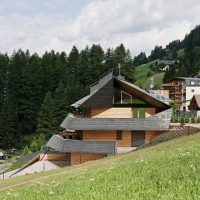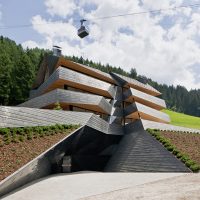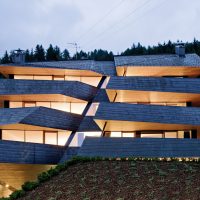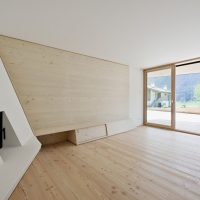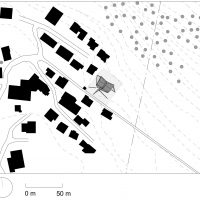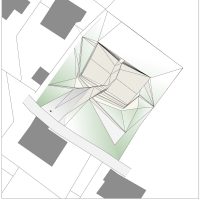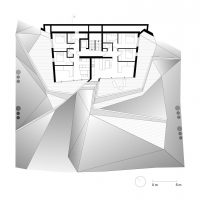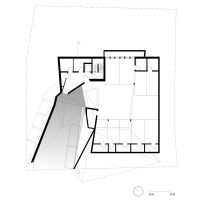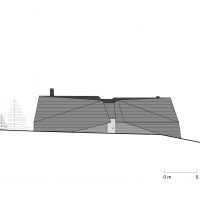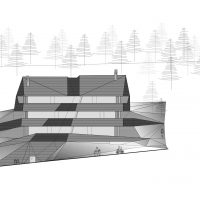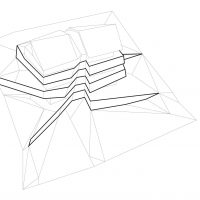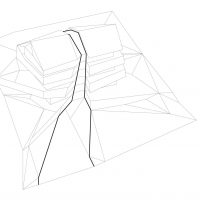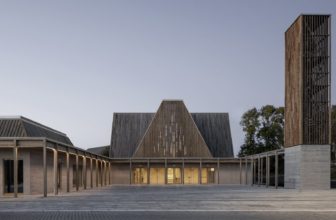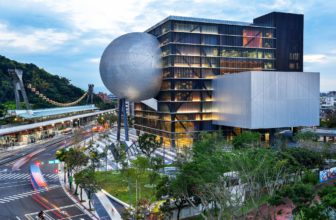Geometry plays an important role in architecture in order to create new spaces and forms. One example of these redefinition is the Dolomitenblick house by PLASMA Studio, whereas elevations emulate the topography of surrounding landscape and slope back making an asymmetric construction. The three-storey Dolomitenblick building contains six holiday homes that each face north-east towards the mountains, welcoming to light and provide panoramic views with its spanning balconies. The eclectic look created by Plasma Studio’s sharp contrast with surrounding topography adds modern charm to Italian countryside vacationing. More details from Plasma Studio comes after the jump.
The building is located on a hillside in the Dolomites, at the edge of a residential area. The volume was in part determined by the functional elements required to host six independent apartments with a common circulation core. A formal incision marks the main access and the division of the units, splitting the main volume in two halves. Apart from its functional connotations, this incision becomes the defining element of the building. From either side of the cut, a strip unfolds to form the balustrade of a generous covered balcony that merges with the surrounding topography. Following the steep natural hillside with each floor, the strips and the façade jump back.
The building hosts six generous holiday homes, all directed to catch the southern sun and the panoramic view of the Dolomites. Each unit is designed to maximize privacy through (1) the splitting of the building volume into two parts, and (2) through the stepped balustrades which block the terrace spaces from views from the unit above and from passers-by. Each apartment enjoys an extension of the internal living area through a covered, sun- and view-facing terrace which terminates in a small private garden. Local larch wood defines internal and external living areas. Floor to ceiling glazing allows for maximum views and solar gain. External sun shades and overhangs from the balconies above minimize overheating during the Summertime.
The main circulation–a continuation of the formal incision–is very compact and repeats the use of the local larch wood and colour code from the façade.
Sited at the edge of a residential area with a very eclectic appearance, we generated a volume which grows out of its surrounding topography and blends into it by reducing the material palette to a very local, almost vernacular, code: larch wood and pre-oxidized copper. Both the copper and the larch wood are subject to a natural change in colour by the atmospheric influence of sun, rain and snow. By borrowing from the colour palette of nearby farmhouses with dark, sunburned larch wood façades, the building blends into its natural surroundings.
Attention was given to the design of the copper balustrades which stem from the natural topography, and wrap around to meet the building at the central incision, peel off again and end once more in the surrounding topography. When peeling off, the metal sheets, divided into horizontal strips, describe a curved hyperbolic-paraboloid geometry. Here, the craftsman’s knowledge is showcased to its full extent.
The dark copper surrounds the volume from all sides. The strips form a second skin, offering shelter and defining the roof as a continuation of the overall façade and building volume. The form of the roof itself draws on the local planning regulation which allows only a pitched roof for this specific building plot. Slightly deformed, it merges with our design concept as well as with the traditional pitched roof typology; not merely through repetition, but rather by exploring its hidden potential.
Project Info:
Architects: PLASMA Studio
Project Year: 2012
Project Area: 1,050 sqm
Photographs: Hertha Hurnaus
Services Technisches: Büro Jud
Fire Safety: Technisches Büro Jud
Sanitary Installations: Egarter Werner
Geological Engineering: Sulzenbacher Ursula
Construction: Tschurtschenthaler Werner GmbH
Security Management: Dr. Ing. Ralf Pellegrini
Electrical Installations: Eltec, Summerer Markus
Project Location: 39030 Sesto, South Tyrol, Italy
Structural Engineering: Dr. Ing. Erlacher Andreas
Design Team: Nicoletta Gerevini, Peter Pichler, Daniela Walder, Maya Shopova, Libny Pacheco
Project Name: Dolomitenblick House
- Courtesy of © Hertha Hurnaus
- Courtesy of © Hertha Hurnaus
- Courtesy of © Hertha Hurnaus
- Courtesy of © Hertha Hurnaus
- Courtesy of © Hertha Hurnaus
- Courtesy of © Hertha Hurnaus
- Courtesy of © Hertha Hurnaus
- Situation Plan
- Site Plan
- Floor Plan
- Floor Plan
- North Elevation
- South Elevation
- West Elevation
- Diagram
- Diagram



